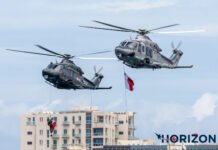The third versatile destroyer in the French Navy is the FREMM Languedoc. Her construction started in 2011, and in 2015, she made her debut to sea.
Her primary function is anti-submarine warfare, although she is also capable of carrying out anti-air, anti-surface, and land attack missions. She is designed to conduct operations either alone or while commanding a task force the vessel can strike strategic targets on the ground.
With a length of 142 meters and a width of 20 meters, she has a displacement of about 6,000 tons, an average draught of 8 meters, and a top speed of 27 knots.

Only 110 people make up the crew because of the high level of automation, with occasionally the addition of members of the naval air arm and special forces.
The propulsion system gives the ability to the ship to sail for up to 45 days straight, or 7000 miles.
A team from Horizon visited the ship on June 26th when it was berthed at Boiler Wharf in Senglea. We were welcomed aboard the frigate by the Communications Officer of the ship, Marc Maurisset. As soon as we started the visit, we noticed the modern and much bigger corridors, more spacious cabins and common areas the frigate offers. The visit kicked off with a short stay in the Officer’s Mess for a short brief about the ship.



Then off we went to the Helicopter deck; nearly all the combat helicopters in the inventory of the French Navy can be supported by the ship’s helicopter deck. The frigate usually embarks the NH-90 Caiman like in this case. The helicopter supports the ship’s missions in anti-submarine warfare, Special forces support, search and rescue and is an immediate link to the ground in terms of logistics.


The frigate has an RHIB on each side and these are lowered in the sea thanks to the crane, it can be lowered on the surface very quickly. Rescues at sea or stopping and boarding another ship suspected of criminal activity are the two principal tasks of the RHIB.


We then visited the galley (kitchen), from the captain to all the seamen, lunch and dinner is served in the galley. After that, they proceed to their own mess. A team of five people—a cook, his deputy, and three assistants—serve 280 meals per day.
The ship is 6 decks high (without the bunkers and roof). There are 58 cabins, 8 dining rooms and relaxation spaces, an infirmary, a gym and a zone for food storage. Technical corridors on both sides. There are cabins for 1, 2 or 4 people, depending on your role and rank.
We then were led into the Combat Information Center (CIC), at the core of the ship. At sea, 8 operators are on watch, regrouped in 4 modules:
- Anti-submarine warfare (1 sonar operator)
- Artillery (1)
- Tactical situation (GE and surface)
- Command (PWO, TPD, CWO)
Here is the place where information is gathered from all sensors and external sources. The information is analyzed by one of the crew in order to draw the current overall tactical situation of the ship, in a rapid, clear and precise way.
Thanks to the Multifunction Radar (MFR), each track is located, identified and categorized. Otherwise, it is considered hostile, if it meets the rules of engagement (ROE) criteria. The ship can also have a tugged sonar to follow submarine tracks. At the battle station, when the ship is threatened, 16 people are in the CIC, among whom is the commander.

It was time to visit the Ship’s bridge, at sea, four seamen are on watch. An officer of the watch (OOW), is wholly responsible for the nautical leading of the ship. His assistant, the quartermaster of the deck, draws the routes on the MXAP and keeps up the diary sheet and the navigation paper. A helmsman pilots the ship according to the OOW’s orders. A lookout monitors the surface situation, using binoculars.
On the right, you can see the desk allowing you to command the heading and speed if the classic system is out of order. Right behind, a multi-function console like the ones in the CIC manages the artillery.
The ship can use 3 propulsion modes:
- Electrical propulsion: 2 electrical engines positioned on the propeller shaft. Flexible and economical (for money and space), it allows the ship to move forward and backwards, up to 17 knots. Silent, it is well adapted for anti-submarine warfare. The engines are supplied by 4 diesel-fueled generating sets.
- Mechanical propulsion: gas turbine (like used for aircraft) to reach high speed (up to 30 knots with nice sea conditions), only forward. At full speed, it consumes 7.5 m3 of gasoil in an hour!
- Rescue propulsion: retractable POD with adjustable blades, propelling the ship up to 6 knots in any direction.
With a fully automatic system, only two personnel are on watch in the Machine Control Room. Consoles offer a complete state of the different installations. It allows the supervision of water and energy production, propulsion and auxiliary circuits.

This was a very informative visit and allowed us to see the new FREMM frigates better. The French Officer really took care of us during our time on the frigate and showed us practically the vessel. Horizon would like to thank the Commander and crew of the French Navy FS Languedoc for accepting us on board the vessel and also the French Embassy in Malta and Rome for their support and help in coordinating the visit.








